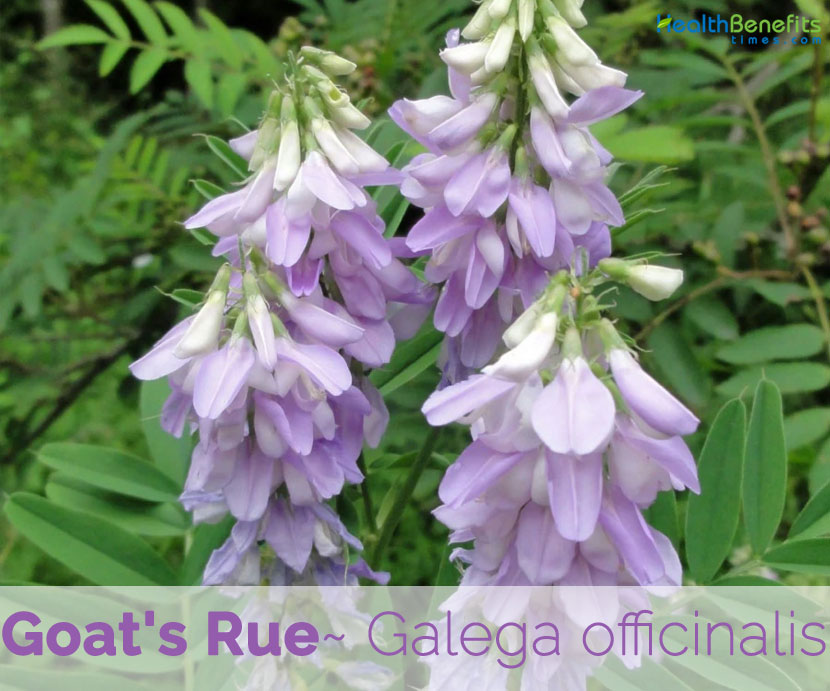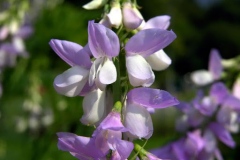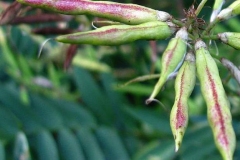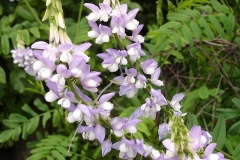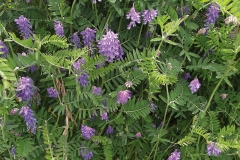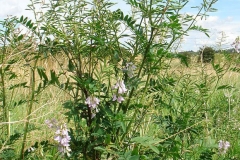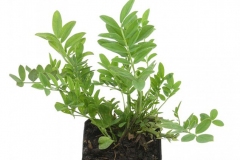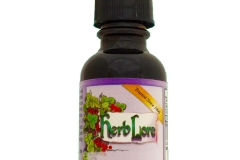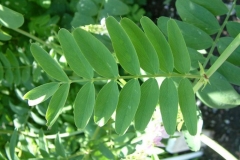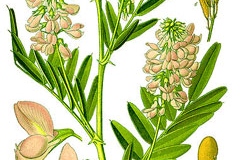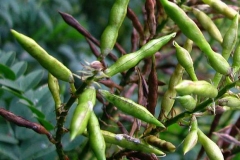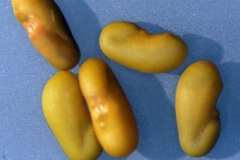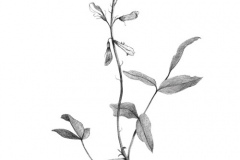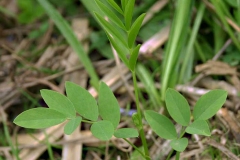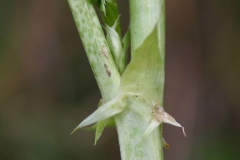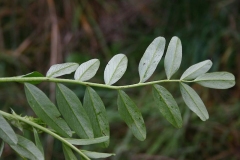The genus name Galega is derived from the Greek word gala, meaning milk and ago meaning ‘to bring on’. The plant was historically used as a galactagogue in small domestic animals. When Linnaeus invented the binomial system of nomenclature, he gave the specific name ‘officinalis’ to plants with an established medicinal, culinary, or other use. The word officinalis is derived from the Latin officina meaning a storeroom (of a monastery) for medicines and necessaries. It literally means ‘of or belonging in an officina’, and that it was officially recognized as a medicinal herb. Goat’s rue is considered safe, but was accidentally discovered to be toxic after the death of sheep that had consumed large quantities. It is unknown exactly why these sheep yielded while other animals remain unaffected.
Goat’s Rue Facts
| Goat's Rue Quick Facts | |
|---|---|
| Name: | Goat's Rue |
| Scientific Name: | Galega officinalis |
| Origin | Middle East, but has been naturalized in Europe and western Asia |
| Shapes | Straight, narrow, smooth pod about 1 inch long |
| Taste | Somewhat bitter and astringent taste |
| Health benefits | Controls Diabetes Mellitus, Brain protection and health, Aids Weight Loss, Increases Lactation, Anti-Inflammatory Agent, Fights against Cancer, High Blood Pressure, Improves lipid profile, Improves heart health |
| Name | Goat’s Rue |
|---|---|
| Scientific Name | Galega officinalis |
| Native | Temperate grassland regions of Middle East, but has been naturalized in Europe and western Asia. It has also been found in South America, North Africa, Pakistan, Turkey, and New Zealand |
| Common Names | Goat’s-rue, Professor Weed, Galega, Common goat’s-rue, Common milkpea, French lilac, Italian fitch |
| Name in Other Languages | Albanian: Qerbash, qerbashi mjekësor Arabic: Madarat makhznia ( مدرة مخزنية) Armenian: Aytsakhot deghagortsakan (Այծախոտ դեղագործական), k’voshp’egena (քոշփեգենա) Azerbaijani: Derman Chepishotu, Dərman çəpişotu Bulgarian: Jablek (жаблек), konski rebra (конски ребра) Catalan: Galega Chinese: Shan yang dou Croatian: ljekoviti orlovac Czech: Jastrabina lekárska, Danish: Lægestregbælg Dutch: Galega, geiteklaver English: Goat’s-rue, Professor Weed, Galega, Professor-weed, Common goat’s-rue, Common milkpea, French lilac, Italian fitch Finnish: Rohtovuohenherne French: Galega Officinal, Lilas D’Espagne, Rue de chèvre, Sainfoin d’Espagne Georgian: Khboshuba German: Arznei-Geißraute, Echte Geissraute, Geißraute, Gewöhnliche Geißraute, Echte Geißraute, Geissraute, Geißklee Greek: Imerotrífillo (ημεροτρίφιλλο) Hebrew: צער העיזים Hungarian: Orvosi kecskeruta, kecskeruta Icelandic: Læknastrábelgur Italian: Capraggine avanese, avanese, capraggine, galega oficinale Lithuanian: Ožiarūtis Macedonian: Zdralka (здралка) Ossetic: Sæg’gærdæg (Сæгъгæрдæг) Persian: شیرین بیان سا Polish: Rutwica lekarska Portuguese: Arruda-caprária, caprária, falso-anil, galega, montana-galega Romanian: Chumera Medichinale, ciumărea Russian: Galega Lekarstvennaya (галега лекарственная), Kozlyatnik Lekarstvennyi (Козлятник лекарственный), kozlyatnik aptechnyy (козлятник аптечный), koz’ya ruta (козья рута) Serbian: Ždraljevina (Ждраљевина), obični orlovac (обични орловац), ljekoviti orlovac (љековити орловац) Shambala: Ždraljevina Slovak: Jastrabina lekárska Slovene: Navadna jastrebina Spanish: Galega, hierba cabruna, hierba galega, ruda cabruna, ruda capraria, ruda galega, índigo falso, alfalfa galega Swedish: Getruta, Getärt, getrutor Turkish: Keçisedefi Ukrainian: Kozlyatnik Likarski, Kozlyatnyk likarsʹkyy (Козлятник лікарський) Upper Sorbian: Lěkarska rutowka Welsh: Ruw’r geifr |
| Plant Growth Habit | Erect, shrubby, colony-forming, woody herbaceous perennial plant |
| Growing Climates | Scrub, woods, marshy fields, roadsides, grasslands, wetlands, river or stream beds, wet, damp meadows, swampland, railway lines, cropland, water-ways, fence lines |
| Soil | Prefers light, medium and heavy soils and can grow in nutritionally poor soil. The plant prefers moist soils that are acid, neutral or basic (alkaline). It prefers full sun, but will tolerate light shade. |
| Plant Size | 2 meters (6 feet) in height |
| Root | Deep taproot |
| Stem | Hollow and cylindrical |
| Leaf | Bright green compound leaves, each leaf typically made up of thirteen to seventeen lance shaped leaflets. These leaflets are approximately 2-5 cm long |
| Flowering season | June to July |
| Flower | White and bluish to purplish pea-like blossoms are borne in terminal or axially racemes |
| Fruit Shape & Size | Straight, narrow, smooth pod about 1 inch long, which points outward and is angled slightly upward from the stem containing up to 9 seeds |
| Seed | Bean-shaped, dull yellow in color, and approximately 2.5-3mm long |
| Seed Color | Dull yellow |
| Propagation | By Seed |
| Taste | Somewhat bitter and astringent taste |
| Plant Parts Used | Aerial parts, flowering stem, seeds, leaves |
| Season | August |
| Health Benefits |
|
| Culinary Facts |
|
Plant Description
Goat’s Rue is an erect, shrubby, colony-forming, woody herbaceous perennial plant that normally grows about 2 meters (6 feet) in height. The plant is found growing in scrub, woods, marshy fields, roadsides, grasslands, wetlands, river or stream beds, wet, damp meadows, swampland, railway lines, cropland, water-ways and fence lines. The plant prefers light, medium and heavy soils and can grow in nutritionally poor soil. The plant prefers moist soils that are acid, neutral or basic. It prefers full sun, but will tolerate light shade. The plant has a deep taproot. The erect, branching stems are smooth and hollowed and support the long floral stalks. The first seedling leaves are large, oval, and dark green. Mature leaves are bright green, alternate, odd-pinnate and compound. Each leaf typically made up of thirteen to seventeen lance shaped leaflets. These leaflets are approximately 2-5 cm long and have small hair like projection on its tips. The stipule (leaf-like appendage at the base of the leaf stem) is sagittate (arrow shaped) and toothed and lobed.
Flowers and fruits
The white and bluish to purplish pea-like blossoms are borne in terminal or axially racemes. Flowering begins in June and continues until frost in the fall. Each blossom produces a straight, narrow, smooth pod, which points outward and is angled slightly upward from the stem. There are 1- 9 seeds per pod and there may be upwards of 15,000 pods per plant. Goats-rue seeds are bean-shaped, dull yellow in color, and about 2 ½ times larger than alfalfa seeds. Seeds drop to the ground when mature and may be spread by water, equipment, or animal manures. Goats-rue seed typically remain dormant until scarified and may remain viable for ten years.
Health benefits of Goat’s Rue
Let’s have a watch at some of the health benefits of goat’s rue:
1. Controls Diabetes Mellitus
Since 1900s Goat’s rue has been used in the treatment of diabetes mellitus. ‘Guanidine’ is the active component present in goat’s rue which helps in lowering the blood glucose levels.
Metformin, a potent anti-hyperglycemic drug is produced from the guanidine derivatives present in goat’s rue. Compounds present in this medicinal plant, encourage the release of insulin, which helps in controlling blood glucose level. It further transports glucose into the cells and tissues and reduces the presence of excess glucose in the blood. The alkaloids present in goat’s rue induce the prolonged hypoglycemic effect.
2. Brain protection and health
In recent years a lot of interesting discoveries are being made connecting previously mentioned Metformin. One example is the Singapore study in which they saw a 51% decreased risk of cognitive impairment with Metformin use. Additionally, they revealed a stronger effect if the patients started taking it at an earlier age.
Building on that, Metformin use is also connected to delaying the development of dementia, Alzheimer’s and Parkinson’s disease.
3. Aids Weight Loss
Goat’s rue is an outstanding anti-obesity agent. Research observed that goat’s rue helped in weight reduction in those who are normal and genetically obese. Intake of goat’s rue along with a calorie-restricted diet helps in losing excess body fat. A high-calorie diet without exercise causes weight as well as fat gain. Guanidine, a precursor to metformin is responsible for this weight loss effect. It suppresses the appetite and delays hunger pangs. Thus, lesser calories enter the system, which may help one to lose weight. It further prevents the storage of fat in the body and helps in fat-burning.
4. Increases Lactation
Goat’s rue is a natural galactagogue and it possesses lactogenic effect. It increases breast milk supply. Phytoestrogens present in goat’s rue are plant chemicals that mimic the action of estrogen. They bind to the estrogen receptors and increase the concentration of prolactin. Prolactin is a hormone responsible for the secretion of milk in breastfeeding mothers.
5. Anti-Inflammatory Agent
Chronic inflammation is the cause of various diseases and disorders. Goat’s rue has the ability to prevent the production of pro-inflammatory compounds, which give rise to inflammation.
Research observed that natural compounds present in goat’s rue prevent the generation of nitric oxide in the body. Nitric oxide, if produced in higher amounts in the body may give rise to serious inflammatory diseases. Thus, by blocking the formation of such a dangerous compound, goat’s rue plays a crucial role in protecting the body against diseases.
6. Fights against Cancer
Scientists have observed that goat’s rue is an excellent anti-cancer agent. Leaves of goat’s rue are a great source of phytoestrogens. These phytoestrogens act similar to estrogen and protect against human breast cancer. These compounds kill the dangerous cancer cells and prevent their spread to other healthy cells of the body. Additionally they prevent the growth and multiplication of the cancer cells and destroy the formation and growth of the tumor.
7. High Blood Pressure
Goat’s rue is effective in lowering high blood pressure due to its anti-hypertensive effects. It extends the arteries and blood vessels and ensures smooth blood flow throughout the body. Hence, it helps in the management of high blood pressure, along with a salt-restricted diet.
8. Improves lipid profile
Regular consumption of goat’s rue helps in improving the overall lipid profile. It reduces the level of LDL ‘bad’ cholesterol in the blood and increases the concentration of HDL ‘good’ cholesterol.
9. Improves heart health
Goat’s rue boosts heart health by reducing the risk factors for heart disease, which include High blood glucose level, altered lipid profile, High blood pressure.
Traditional uses and benefits of Goat’s Rue
- Goat’s rue was once important in the treatment of plague, fevers and infectious diseases.
- Plant consists of galegine, an alkaloid that strongly decreases blood sugar levels which make it useful in the treatment of diabetes.
- Leaves and flowering tops are diaphoretic, diuretic, galactogogue and hypo-glycaemic.
- It has also been used in the treatment of fevers.
- It is taken internally to treat insufficient lactation, late-onset diabetes, pancreatitis and digestive problems, especially chronic constipation caused by a lack of digestive enzymes.
- The plant is harvested as it is just coming into flower and is dried for later use.
- Goat’s rue and its derivatives have been used in the management of diabetes mellitus to reduce blood sugar levels.
- It has tonic, liver protectant, and platelet aggregation inhibitory effects, and has been evaluated for its diuretic and weight loss effects.
- It is believed to have been used as a diuretic and tonic for typhoid conditions and as a nervous system stimulant.
- Goat’s rue has been used as a soak for tired feet and as an herb in cheese making.
- Hill’s Universal Herbal mentions the addition of the dried flowers to boiling water to make an infusion for drinking to induce sweating and reduce fever.
- Goat’s rue has been shown to increase milk production in lactating animals and in breast-feeding mothers.
- Other uses it as a stimulant for adrenal glands and pancreas, to protect the liver, for digestive problems, diaphoretic properties and to start the flow of breast milk.
- Remedies made from the goat’s rue were at one time used in treating was problems like the plague, infestation of intestinal worms, to bring down fevers, and as a cure for snakebites and other problems.
- In Medieval times the herb was mainly used to dispel worms, cure the bites of venomous beasts and to improve digestion.
How to Consume Goat’s rue
Goat’s rue can be consumed in for of tea. Its capsules are also available in the market.
Goat’s Rue Tea
Goat’s rue is commonly consumed in the form of tea. It is available in the market or you can even prepare it at home. How to make this tea:
Boil 1 teaspoon goat’s rue in 1 cup of water for 2-3 minutes. You can drink this tea 2-3 times a day. You can improve the flavor the tea by adding one of the below-mentioned ingredients:
- Cinnamon
- Ginger
- Cardamom
- Fennel seeds
Goat’s Rue Capsules
Goat’s rue capsules are available in the market, but one should ask their doctor before starting with these capsules. Purchase these capsules from a reliable source
Other Facts
- It is a fast-growing plant, it makes a good green manure crop, enriching the soil with organic matter and also fixing atmospheric nitrogen.
- The plant is used cosmetically in hand and foot bathes.
- A single plant may produce upwards of 15,000 pods.
- The plant has potential as a natural fertilizer on saline soils.
- An extract is used as an ingredient in commercial cosmetic preparations, where it acts as a skin conditioner.
Precautions
- It may cause allergic reactions.
- Stop using this herb at least 2 weeks before a scheduled surgery as it may interfere with your blood glucose levels.
- Goat’s rue may inhibit with prescribed diabetes drugs, iron absorption, and anticoagulants.
- It may cause headache or muscular weakness, and its safety during pregnancy or breastfeeding is unknown.
- Oral toxicity of this plant can affect the liver and lungs and thus, have a negative impact on health.
- Do not use goat’s rue if you have diabetes or hypoglycemia unless you are under the direct care of your doctor.
- Avoid this herb if you tend to have an overabundant breast milk supply. Goat’s rue could further increase your milk supply and lead to breastfeeding problems such as breast engorgement, plugged milk ducts, and mastitis.
Control and Management
- Manual: Mowing, clipping, cutting, and shallow cultivation are poor means of control because the plant will flower and produce seed even when very small. Alternate cropping and row crops are effective deterrents since the cultivation interrupts the life cycle of goats-rue.
- Chemical: It can be effectively controlled using any of several readily available general use herbicides such as glyphosate. Follow label and state requirements. Crowns of treated plants may remain viable up to seven years unless retreated or excavated and removed.
References:
https://www.itis.gov/servlet/SingleRpt/SingleRpt?search_topic=TSN&search_value=26706#null
http://www.hear.org/pier/species/galega_officinalis.htm
https://pfaf.org/user/Plant.aspx?LatinName=Galega+officinalis
https://www.cabi.org/isc/datasheet/24756
https://www.drugs.com/npp/goat-s-rue.html
https://botanical.com/botanical/mgmh/r/ruegoa21.html
https://gd.eppo.int/taxon/GAGOF
http://www.theplantlist.org/tpl1.1/record/ild-7674
https://en.wikipedia.org/wiki/Galega_officinalis
https://plants.usda.gov/core/profile?symbol=GAOF
https://www.invasiveplantatlas.org/subject.html?sub=4535
http://www.narc.gov.jo/gringlobal/taxonomydetail.aspx?id=70971
https://www.invasive.org/weedcd/pdfs/wow/goats-rue.pdf


